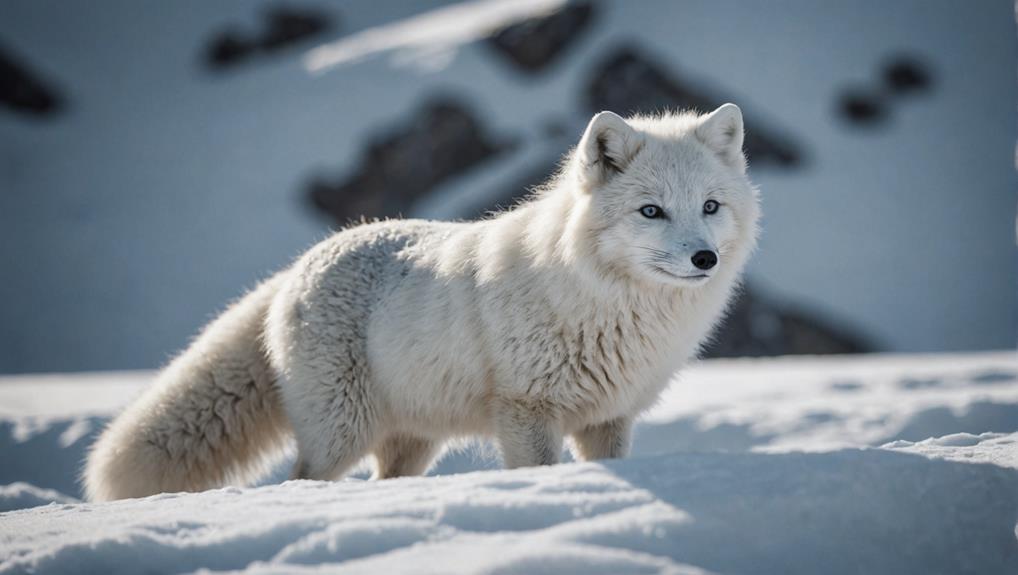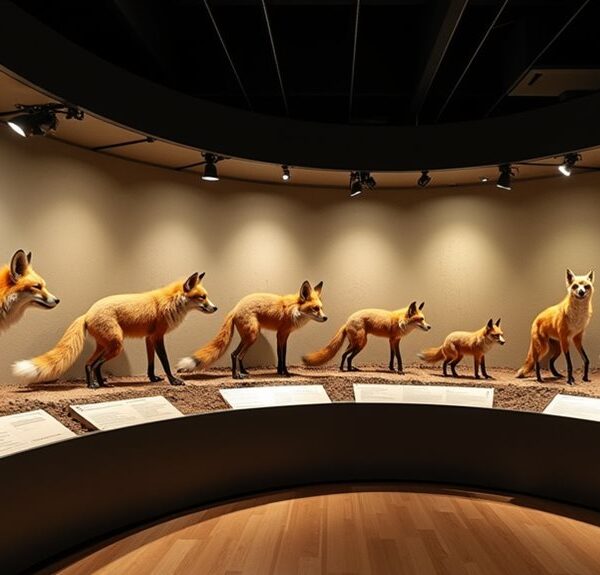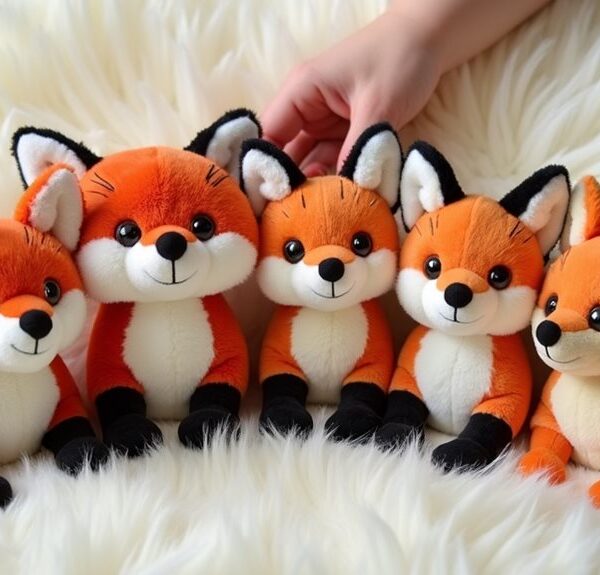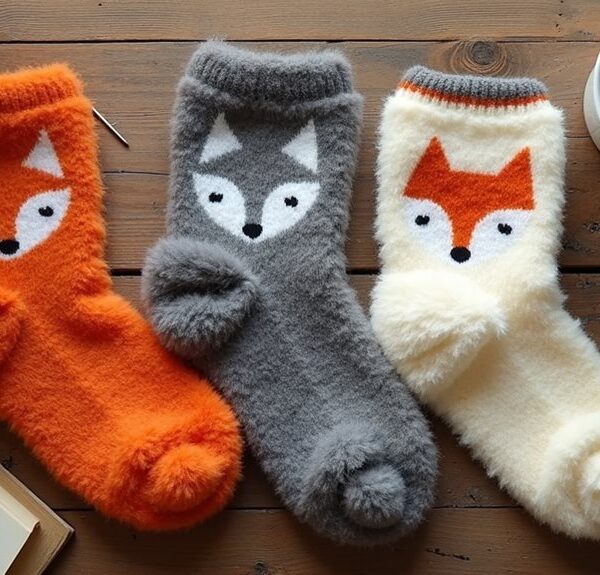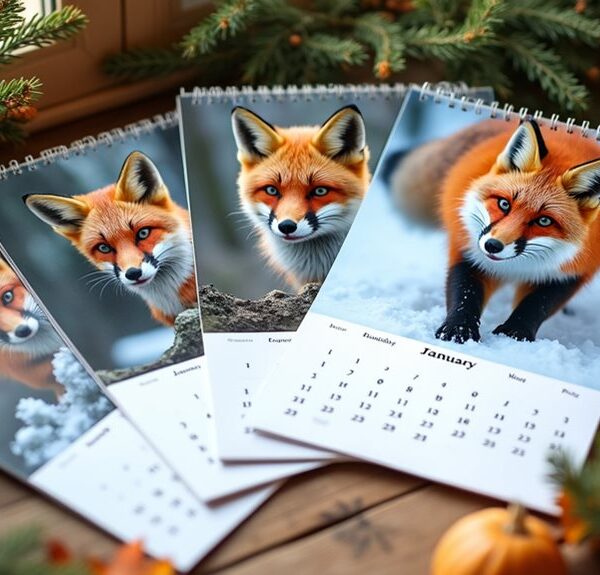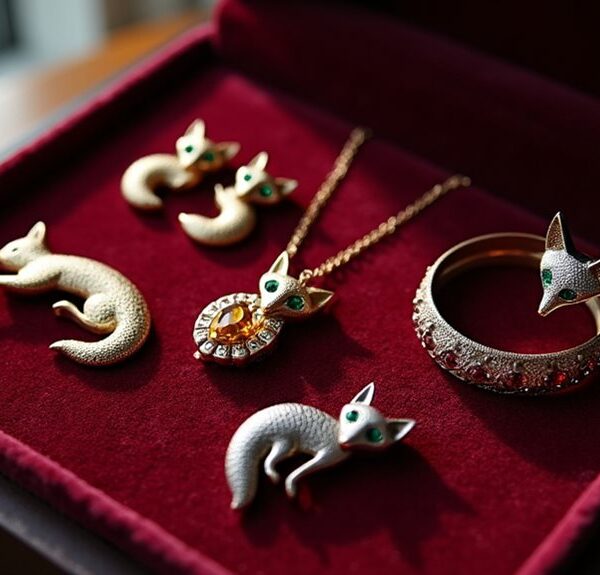Arctic foxes are like the ultimate survival experts in freezing temperatures, hitting lows of -58°F! They're decked out with thick, double-layered fur that not only keeps them cozy but changes color, blending in with their snowy surroundings. Their compact bodies help retain heat, while bushy tails offer extra warmth—or a stylish accessory while they snooze! With keen senses, they can sniff out snacks under snow, making them savvy hunters. Plus, they stockpile food, just in case, which is pretty clever. If you think these little guys are fascinating, stick around to uncover more about their clever tactics and challenges!
Contents
Overview of Arctic Foxes
Arctic foxes, weighing between 3 to 8 kg and measuring 45-67 cm in length, are fascinating creatures adapted to some of the harshest environments on Earth. These small, furry animals thrive in the Arctic regions of North America, Europe, and Asia.
One of their most remarkable adaptations is their ability to change fur color with the seasons. In winter, they sport an all-white coat that blends perfectly into the snowy landscape, while in summer, they switch to a brown or gray coat to camouflage against the rocky tundra.
Their compact bodies, with short legs and small ears, help them conserve heat, making them well-equipped for frigid temperatures. You'll often find them hunting alone, but during breeding season, they form pairs, showcasing their unique social structures.
They primarily feast on lemmings and other small mammals, but they're also opportunistic feeders, scavenging polar bear carcasses when the chance arises.
As climate change continues to threaten their habitats, understanding these adaptations that allow Arctic foxes to survive becomes crucial. By supporting conservation efforts, you can help ensure these charming creatures continue to thrive in their icy homes.
Key Adaptations for Survival
In the harsh Arctic environment, survival hinges on a variety of key adaptations that help foxes thrive. You mightn't realize just how cleverly these little creatures have evolved to handle such extreme conditions!
- Thick Fur: Their double-layered coat not only keeps them warm but also changes color with the seasons for camouflage.
- Compact Bodies: With short legs and small ears, Arctic foxes minimize heat loss, making them experts at staying cozy.
- Bushy Tail: Their fluffy tail acts like a personal blanket, wrapping around them during chilly naps.
- Fur-Covered Paws: These help them grip slippery ice and protect their feet from the cold, allowing them to dash across snowy terrain.
- Keen Senses: With a sharp sense of smell and hearing, they can sniff out dinner hiding beneath the snow, ensuring they don't go hungry.
Thanks to these adaptations, the Arctic fox population can flourish even in the most unforgiving climates.
Habitat Characteristics
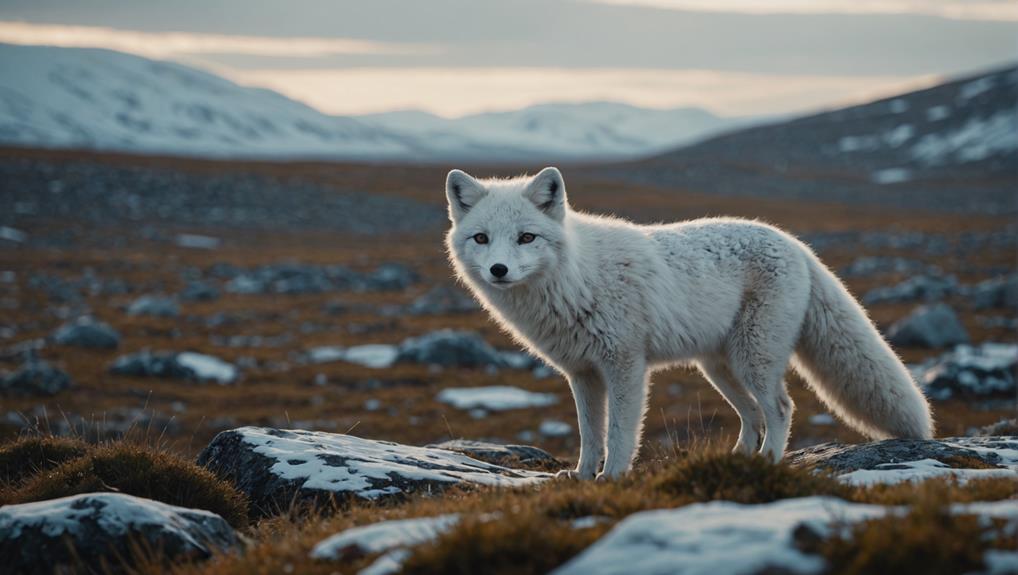
When you think about Arctic foxes, picture them thriving in the chilly, treeless tundra, where the wind can be a fierce companion.
To survive in such a harsh environment, these clever little creatures build impressive dens that not only keep them warm but also serve as family homes for generations.
It's fascinating how they've adapted to their surroundings, making the most of every season, even when the plants seem to take a vacation!
Tundra Environment Adaptations
The tundra biome poses unique challenges with its freezing temperatures and limited vegetation, yet Arctic foxes have evolved remarkable adaptations to thrive in this harsh environment. You might wonder how these clever little creatures manage to stay warm and find food amid such adversity.
Well, let's dive into their incredible adaptations!
- Compact Body Design: Their round bodies minimize exposure to the cold, helping them conserve heat.
- Thick, Double-Layered Fur: This insulation keeps them warm, changing color from white in winter to brown/gray in summer for camouflage.
- Padded Fur on Paws: They've got natural insulation on their paws, making it easier to move across snow and ice.
- Elaborate Dens: Arctic foxes dig intricate dens to provide shelter from extreme weather, offering a cozy spot for raising families.
- Seasonal Changes: Their fur color change not only helps with warmth but also aids in blending into the tundra environment.
These adaptations show just how resourceful Arctic foxes are.
Next time you think of the tundra, remember these little furballs and their amazing ways of surviving!
Shelter Construction Techniques
Arctic foxes really know how to dig in and create impressive shelters that withstand the brutal conditions of the tundra. These clever creatures construct elaborate dens that serve as their Arctic fox habitat, often used by multiple generations. Imagine a cozy den, with multiple entrances, providing a safe haven from predators and the wild Arctic environment.
When choosing where to dig, Arctic foxes look for well-drained, elevated areas. This smart choice helps them avoid flooding during thaw periods, keeping their home dry and comfy. Sometimes, they even modify existing burrows made by other animals. Talk about resourcefulness! They really know how to make the most of what's around.
During those hot summer months, these dens offer a cool microhabitat. It's like having air conditioning in the Arctic! This stable environment is perfect for raising their young ones.
Dietary Needs and Strategies
Often, Arctic foxes demonstrate remarkable adaptability in their dietary needs and strategies, allowing them to thrive in harsh tundra environments.
As opportunistic feeders, these clever little creatures know how to make the most of what's available. They primarily feast on lemmings, but their menu is diverse and delicious!
Here are some key aspects of their diet:
- Lemmings, which are plentiful in winter
- Voles, birds, and fish for variety
- Eggs, perfect for a quick protein boost
- Berries and insects during the summer months
- Scavenged remains from larger predators, like polar bears
What's truly fascinating is how they adjust their diet seasonally.
When resources change, Arctic foxes don't panic; they simply adapt! Their keen senses of smell and hearing help them locate prey even under thick snow.
Imagine digging in the snow with a nose for dinner! This versatility in their dietary needs proves that Arctic foxes aren't just survivors; they're masters of their environment.
Reproductive Behavior
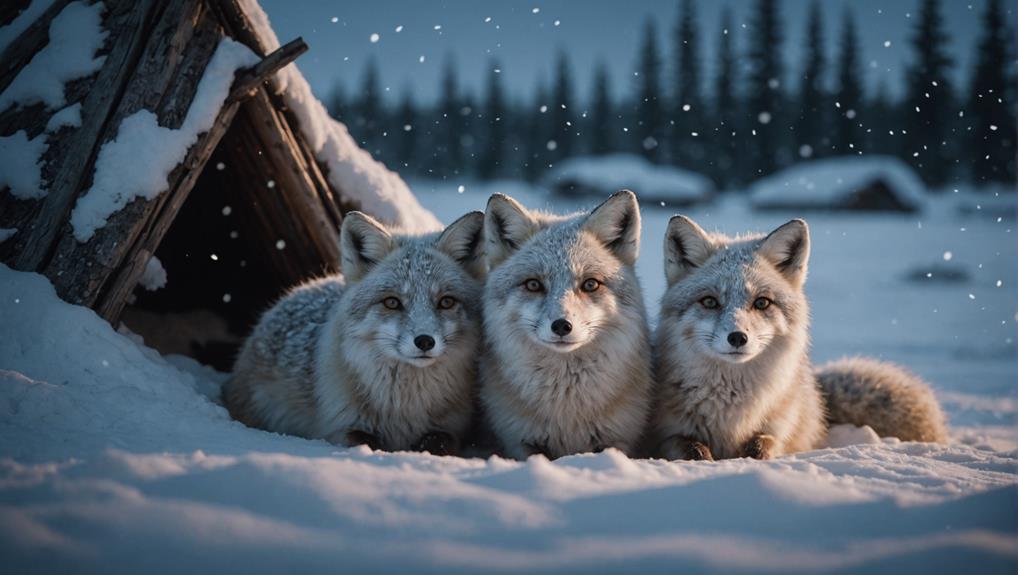
When spring rolls around, Arctic foxes gear up for their exciting mating season, usually between March and June.
You'll find them digging cozy dens in hillside slopes or under snow drifts, and they often return to the same spots for generations.
With both parents pitching in—dad brings home the food while mom handles the nursing—the kits grow up surrounded by love and care, all while learning the ropes of fox life!
Mating Season Dynamics
During the breeding season, you'll find that Arctic foxes form strong monogamous pairs, a crucial aspect of their reproductive behavior. This commitment kicks off in late winter, around January to February, setting the stage for new life.
After a gestation period of about 52 days, the female gives birth to a litter of kits—usually between 5 to 10, though sometimes more if food is plentiful.
Here's what makes their mating season fascinating:
- Shared Responsibilities: Both parents pitch in for the kits, with dads foraging and bringing home the bacon (or, in this case, small rodents).
- Territory Defense: They establish a safe breeding territory, fiercely protecting it from predators.
- Family Time: The whole family sticks together until the kits are about 6 months old, creating a close-knit unit.
- Successful Parenting: The shared care ensures the little ones are well-fed and nurtured until they're ready to explore.
- Adaptability: Their breeding dynamics reflect the changing environment, showcasing their resilience.
Denning and Kit Rearing
As Arctic foxes breed in March or April, they create dens in the tundra to ensure a safe environment for their young. These dens aren't just simple holes in the ground; they can be quite elaborate! Often, the foxes use old burrows from other animals or dig new ones, which can have multiple chambers and entrances. This design helps protect the kits from predators and harsh weather.
Typically, a litter consists of 5 to 10 kits, born in late April to early May. Both parents are hands-on when it comes to rearing their little ones. For about 8 to 10 weeks, the kits are nursed while their parents hunt for food. It's a team effort, and teamwork is key to survival!
Here's a quick overview of the denning process:
| Stage | Description | Importance |
|---|---|---|
| Den Creation | Use old burrows or dig new ones | Safety from predators |
| Kit Birth | 5 to 10 kits born in late April | Continuation of species |
| Nursing Period | Kits nursed for 8 to 10 weeks | Vital early growth |
| Survival Skills | Kits learn essential skills around 3 months | Independence and exploration |
| Parental Involvement | Both parents participate in rearing | Strong family unit |
This nurturing environment is crucial for the kits' survival as they grow and explore their Arctic home!
Parental Care Practices
Building on the foundation of their elaborate dens, Arctic foxes demonstrate remarkable parental care practices. These devoted parents work together to ensure their pups thrive in the harsh Arctic environment. You'll find it heartwarming how both the male and female foxes share the responsibilities of raising their young.
Here are some fascinating aspects of their parental care:
- They typically give birth to 5 to 14 pups, depending on food availability.
- The parents create a network of dens, offering a safe haven for their little ones.
- Early on, they actively hunt and bring back food, even regurgitating meals for the pups.
- Teaching essential survival skills, like hunting techniques, is part of their job!
- Pups usually gain independence around 10-12 weeks of age.
The dedication of Arctic foxes in nurturing their young shines through their actions. By providing food and a stable home, they ensure their pups grow strong and capable.
It's a beautiful dance of teamwork, love, and survival that showcases the incredible bond between these furry families. You can't help but admire their commitment to raising the next generation in a challenging world!
Predatory Threats
Predatory threats are a constant concern for Arctic foxes, who must navigate a landscape filled with larger carnivores. These clever little creatures have adapted remarkably to keep themselves safe. Their compact body design and rounded ears help them maintain body temperature in the freezing cold, which is crucial for survival. Plus, their fur changes to white in winter, providing perfect camouflage against the snow. This helps them sneak around without being spotted by hungry predators.
To highlight their survival tactics, take a look at the table below:
| Strategy | Description | Emotional Impact |
|---|---|---|
| Camouflage | Fur changes color with the seasons | A sense of safety |
| Territorial Behavior | Marks territory to deter rivals | A feeling of control |
| Keen Sense of Smell | Detects prey and dangers below snow | Heightened awareness |
| Caching Food | Stores extra food for tough times | Assurance of sustenance |
| Compact Body Design | Reduces heat loss, keeps them warm | Warmth in harshness |
Impact of Climate Change
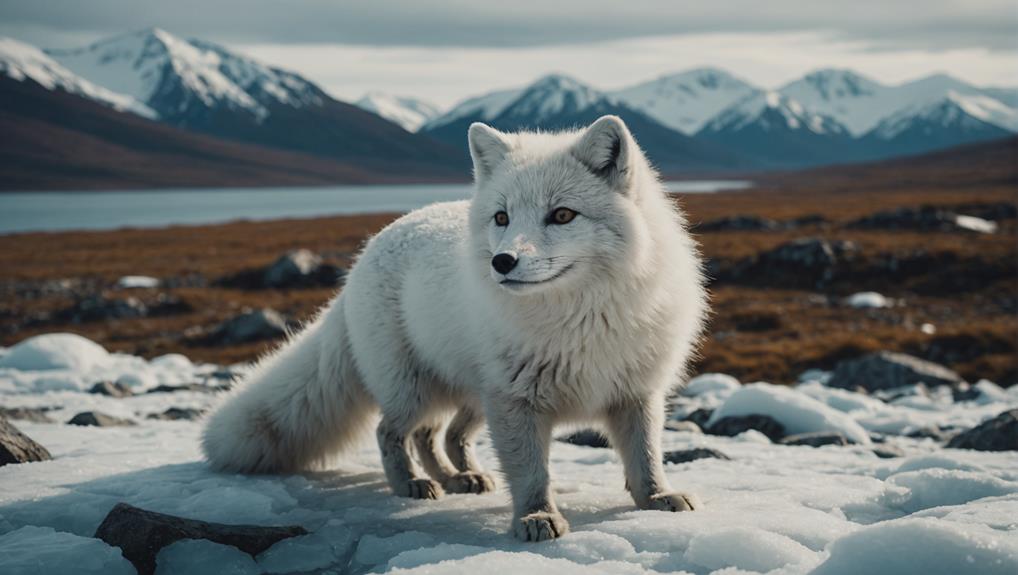
The rapid changes in the Arctic environment due to climate change pose significant challenges for Arctic foxes. As the temperatures rise, their icy homes are melting away, leading to habitat loss that's hard to ignore.
Here's how climate change impacts these adorable creatures:
- Less snow means poor camouflage, making it tough to hunt.
- Warming temperatures disrupt the tundra ecosystem they depend on.
- Lemmings, a primary food source, become harder to find as their populations fluctuate.
- Increased competition arises, especially with red foxes moving into their territory.
- Behavioral changes may be necessary for survival in this new world.
You might think these little foxes are tough, and they are! But even they struggle with the challenges of warming temperatures and habitat loss.
As their environment shifts, Arctic foxes face a race against time to adapt and thrive. It's a reminder for all of us about the importance of protecting our planet. Every little effort counts.
Conservation Initiatives
As Arctic foxes face mounting pressures from climate change, concerted conservation initiatives are stepping in to help. You mightn't realize how vital these little creatures are to their tundra home. That's why raising awareness about habitat degradation is so important. Many organizations are forming partnerships to monitor Arctic fox populations and see how climate change impacts their habitats.
One of the key focuses of these conservation initiatives is habitat preservation. By restoring areas in the Arctic, we can create better living conditions for these adorable foxes. Plus, campaigns against hunting and fur farming are crucial in keeping their numbers stable. After all, no one wants to see these furry friends disappear!
Educational programs also play a big part in these efforts. They inform communities about the ecological importance of Arctic foxes. When people understand the role these foxes play, they're more likely to support conservation efforts.
And let's face it—who wouldn't want to help protect such a cute and resourceful animal? Together, we can make a difference and ensure Arctic foxes thrive in the face of climate change.
Supporting Arctic Fox Conservation
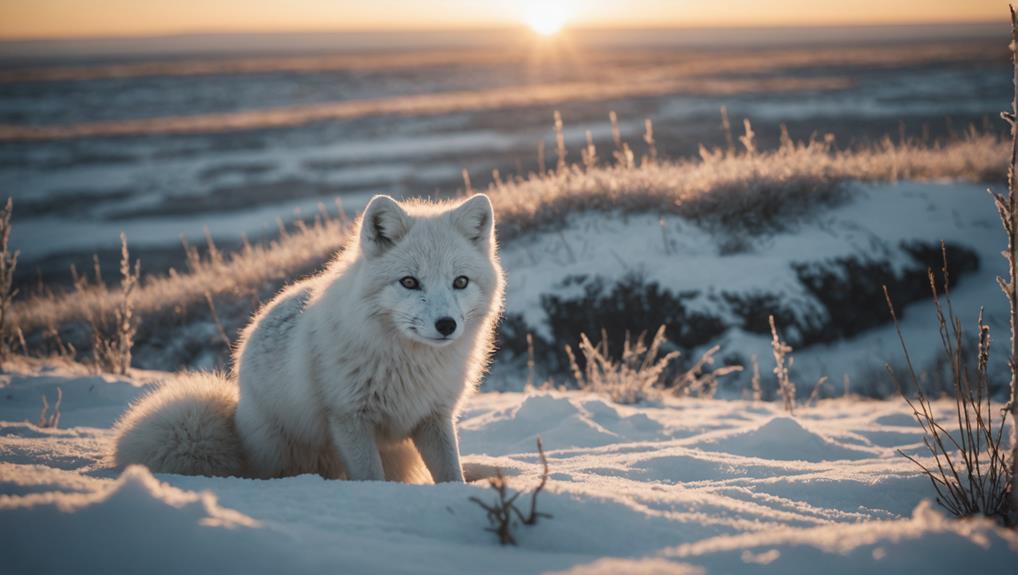
How can you contribute to supporting Arctic fox conservation? Every little action counts, and you can make a difference! Here are some ways to get involved:
- Educate yourself and others about the importance of Arctic foxes in our ecosystem.
- Support organizations that focus on habitat protection and advocate against drilling in sensitive areas.
- Participate in local conservation efforts or volunteer with wildlife groups.
- Share your passion for Arctic foxes on social media to raise awareness about climate change and its impacts.
- Promote sustainable practices in your own life to help reduce the effects of climate change.
Final Thoughts
In conclusion, Arctic foxes are truly remarkable creatures, equipped with amazing adaptations that help them thrive in harsh conditions. They've got a knack for survival, whether it's their fluffy winter coat or clever hunting tactics. But let's not forget, they face real challenges from climate change and other threats. By supporting conservation efforts, we can help these adorable little foxes continue to roam the Arctic. After all, who wouldn't want to see those fluffy tails dancing across the snow?

